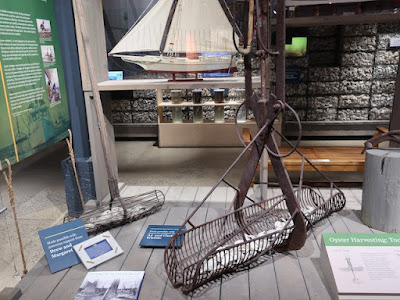Thanks to a pass from
the local library, we were able to visit the
Annapolis Maritime Museum and Park for free!
The museum is housed in the former McNasby's Seafood and Oyster Company, a plant that canned mostly oysters but also other foodstuff taken from the Chesapeake Bay.
 |
| Looks like an industrial building, except for the mural |
 |
| The entrance |
 |
| The original sign outside |
The museum chronicles the history of the Chesapeake from the first settlement of Europeans to today. Some of the exhibit are very high-tech, including video games that can be played on a touch-screen table (harvesting oysters) or on a VR headset (which wasn't working the day we visited).
 |
| My children try to dominate the oyster market. Ah, capitalism! |
 |
| VR station |
One book has minimal writing on it, but a projector aimed down at it shows different images depending on which page is open. It's almost like reading the
Daily Prophet from Harry Potter. The set-up is a great way to make the information more memorable.
 |
| A magical book! |
Back in the 1700s and 1800s, oyster harvesting was mostly done by individuals with simple tools. One display shows the tongs used to scoop up oysters from the bay bed. Dredgers were hauled behind boats to harvest more oysters more quickly.
 |
| Two types of tongs |
 |
| A dredger |
Annapolis became a prosperous place since the oyster population was so great and demand was quite large too. They referred to them as "White Gold." As with any valuable commodity, conflict was bound to ensue.
 |
| I didn't make that up! |
Harvesting became so popular that regulations were put in place. Dredgers could only work in certain areas and tongers had protected areas for their harvesting. Maryland had laws against some mechanical harvesters. Virginia did not. Soon enough, oyster wars broke out between the different groups (Maryland tongers vs. Maryland dredgers, Maryland harvesters vs. Virginia harvesters, etc.). Maryland created the Maryland State Oyster Police Force to ensure the rules were being followed, so conflict options expanded. Guns and even cannon became involved.
 |
| Civil War cannon repurposed for oyster wars |
Another display shows various recipes for oysters, dating back 200 years!
 |
| Dining advice! |
The back wall has a display on the conditions of the bay. When the first English colonists came, the bay was clear and oysters numbered in the millions. By the 21st century, conditions have worsened and the oyster population has significantly dropped.
 |
| Recreation of 1600s Chesapeake |
 |
| Recreation of 2000s Chesapeake |
The wall features a sort of bar graph of the drop in population. The picture below shows the various cages and how less and less they are filled further down the hall.
 |
| Also, the water quality changes |
Another high-tech exhibit has a factory worker describing the process of shucking and storing the oysters for canning.
 |
| That guy isn't really there, even though he talks to you |
 |
| Other tools of the trade |
Several model boats are on display, including
Bugeyes and
Skipjacks.
 |
| Sample of a bugeye boat |
 |
| A model skipjack |
Local volunteers helped to restore the
Wilma Lee, a skipjack that now serves as a cruise boat that can be rented for parties or used for education on the water.
 |
| The Wilma Lee |
 |
| The front of the boat |
The museum has a small pier with a nice view of the Chespeake and the Bay Bridge in the distance.
 |
| A beach across the way |
 |
| Bay Bridge in the distance |
 |
| Mosaic of the product made here |
We were grateful to the library for having a free pass and for the museum not being too huge. It is a lot of fun to visit.


























No comments:
Post a Comment